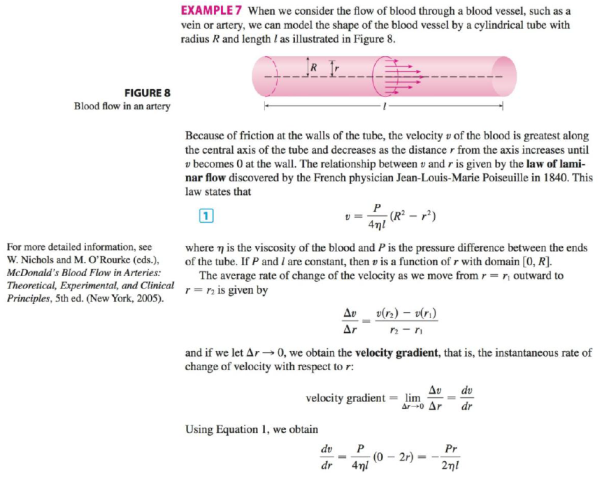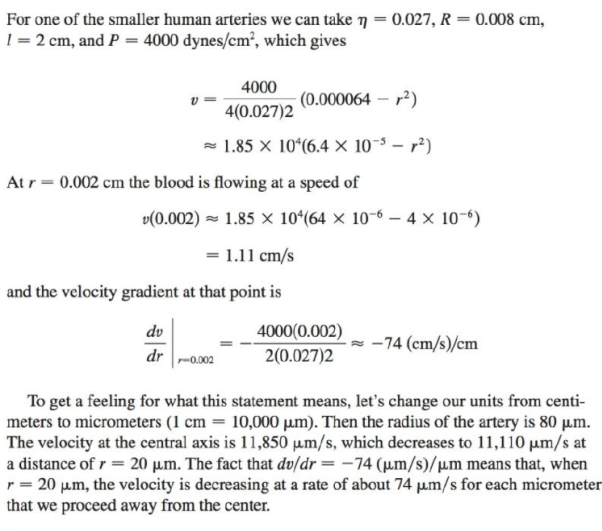
Concept explainers
Refer to the law of laminar flow given in Example 7. Consider a blood vessel with radius 0.01 cm, length 3 cm, pressure difference 3000 dynes/cm2, and viscosity η = 0.027.
(a) Find the velocity of the blood along the center-line r = 0, at radius r = 0.005 cm, and at the wall r = R = 0.01 cm.
(b) Find the velocity gradient at r = 0, r = 0.005, and r = 0.01.
(c) Where is the velocity the greatest? Where is the velocity changing most?
EXAMPLE 7


(a)
To find: The velocity of the blood along the center line
Answer to Problem 27E
Velocity of the blood along the center line is
Velocity of the blood at 0.005cm as radius is
Velocity of the blood at the wall is
Explanation of Solution
Given:
The law of laminar flow is as given below.
The length of the blood vessel is given below.
The pressure difference between the ends of the vessel is given below.
The viscosity of the blood is given below.
Calculation:
Calculate the velocity of the blood along the center line using the equation (1).
Substitute 3cm for
Thus, the Velocity of the blood at
Calculate the velocity of the blood at
Substitute 3 cm for
Thus, the Velocity of the blood at
Calculate the velocity of the blood at the wall using the equation (1).
Substitute 3 cm for
Thus, the Velocity of the blood at
(b)
To find: The velocity gradient at
Answer to Problem 27E
Velocity gradient at
Velocity gradient at
Velocity gradient at
Explanation of Solution
Calculate the velocity gradient at center line
Differentiate equation (1) with respect to
Substitute 3 cm for
Thus, the Velocity of the blood at radius
Calculate the velocity gradient at
Substitute 3 cm for
The velocity gradient at
Calculate the velocity gradient at the wall edge
Substitute 3 cm for
The velocity gradient at
(c)
To find: Where is the velocity the greatest and where it changes the most.
Answer to Problem 27E
The velocity is greatest where
Explanation of Solution
The velocity is greatest where
Chapter 3 Solutions
Single Variable Calculus: Concepts and Contexts, Enhanced Edition
Additional Math Textbook Solutions
Elementary & Intermediate Algebra
Precalculus: A Unit Circle Approach (3rd Edition)
Precalculus
Calculus: Early Transcendentals (2nd Edition)
Graphical Approach To College Algebra
College Algebra (Collegiate Math)
- Find all solutions for v when v5 - 3q = 0.arrow_forwardHow would i solve this. More info is that b =1 but it might be better to solve this before making the substitutionarrow_forwardLet m(t) be a continuous function with a domain of all real numbers. The table below shows some of the values of m(t) . Assume the characteristics of this function are represented in the table. t -3 -2 8 11 12 m(t) -7 6 3 -9 0 (a) The point (-3, -7) is on the graph of m(t). Find the corresponding point on the graph of the transformation y = -m(t) + 17. (b) The point (8, 3) is on the graph of m(t). Find the corresponding point on the graph of the transformation y = -m (−t) . 24 (c) Find f(12), if we know that f(t) = |m (t − 1)| f(12) =arrow_forward
- Suppose the number of people who register to attend the Tucson Festival of Books can be modeled by P(t) = k(1.1), where t is the number of days since the registration window opened. Assume k is a positive constant. Which of the following represents how long it will take in days for the number of people who register to double? t = In(1.1) In(2) In(2) t = In(1.1) In(1.1) t = t = t = In(2) - In(k) In(2) In(k) + In(1.1) In(2) - In(k) In(1.1)arrow_forwardUse the method of washers to find the volume of the solid that is obtained when the region between the graphs f(x) = √√2 and g(x) = secx over the interval ≤x≤ is rotated about the x-axis.arrow_forward5 Use the method of disks to find the volume of the solid that is obtained when the region under the curve y = over the interval [4,17] is rotated about the x-axis.arrow_forward
- 3. Use the method of washers to find the volume of the solid that is obtained when the region between the graphs f(x) = √√2 and g(x) = secx over the interval ≤x≤ is rotated about the x-axis.arrow_forward4. Use cylindrical shells to find the volume of the solid generated when the region enclosed by the given curves is revolved about the x-axis. y = √√x, y = 0, y = √√3arrow_forward5 4 3 21 N -5-4-3-2 -1 -2 -3 -4 1 2 3 4 5 -5+ Write an equation for the function graphed above y =arrow_forward
- 6 5 4 3 2 1 -5 -4-3-2-1 1 5 6 -1 23 -2 -3 -4 -5 The graph above is a transformation of the function f(x) = |x| Write an equation for the function graphed above g(x) =arrow_forwardThe graph of y x² is shown on the grid. Graph y = = (x+3)² – 1. +10+ 69 8 7 5 4 9 432 6. 7 8 9 10 1 10 -9 -8 -7 -6 -5 -4 -3 -2 -1 1 2 3 4 5 -2 -3 -4 -5 -6- Clear All Draw:arrow_forwardSketch a graph of f(x) = 2(x − 2)² − 3 4 3 2 1 5 ས་ -5 -4 -3 -2 -1 1 2 3 4 -1 -2 -3 -4 -5+ Clear All Draw:arrow_forward
 Calculus: Early TranscendentalsCalculusISBN:9781285741550Author:James StewartPublisher:Cengage Learning
Calculus: Early TranscendentalsCalculusISBN:9781285741550Author:James StewartPublisher:Cengage Learning Thomas' Calculus (14th Edition)CalculusISBN:9780134438986Author:Joel R. Hass, Christopher E. Heil, Maurice D. WeirPublisher:PEARSON
Thomas' Calculus (14th Edition)CalculusISBN:9780134438986Author:Joel R. Hass, Christopher E. Heil, Maurice D. WeirPublisher:PEARSON Calculus: Early Transcendentals (3rd Edition)CalculusISBN:9780134763644Author:William L. Briggs, Lyle Cochran, Bernard Gillett, Eric SchulzPublisher:PEARSON
Calculus: Early Transcendentals (3rd Edition)CalculusISBN:9780134763644Author:William L. Briggs, Lyle Cochran, Bernard Gillett, Eric SchulzPublisher:PEARSON Calculus: Early TranscendentalsCalculusISBN:9781319050740Author:Jon Rogawski, Colin Adams, Robert FranzosaPublisher:W. H. Freeman
Calculus: Early TranscendentalsCalculusISBN:9781319050740Author:Jon Rogawski, Colin Adams, Robert FranzosaPublisher:W. H. Freeman
 Calculus: Early Transcendental FunctionsCalculusISBN:9781337552516Author:Ron Larson, Bruce H. EdwardsPublisher:Cengage Learning
Calculus: Early Transcendental FunctionsCalculusISBN:9781337552516Author:Ron Larson, Bruce H. EdwardsPublisher:Cengage Learning





